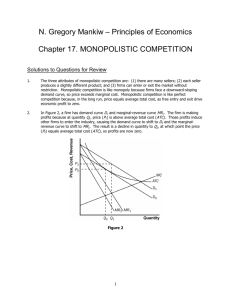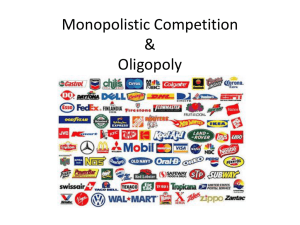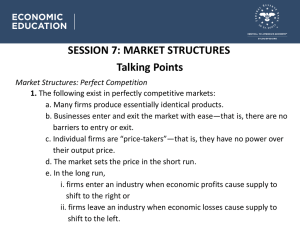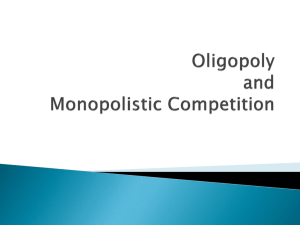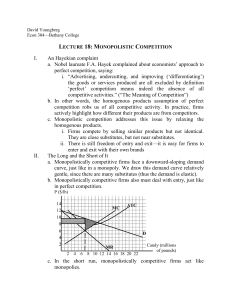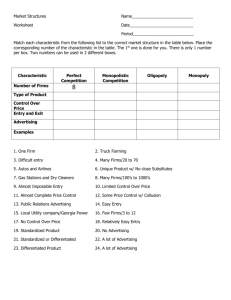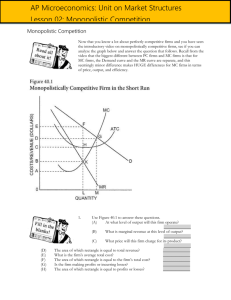Monopolistic Competition • Attributes of Monopolistic Competition Many sellers Product differentiation
advertisement
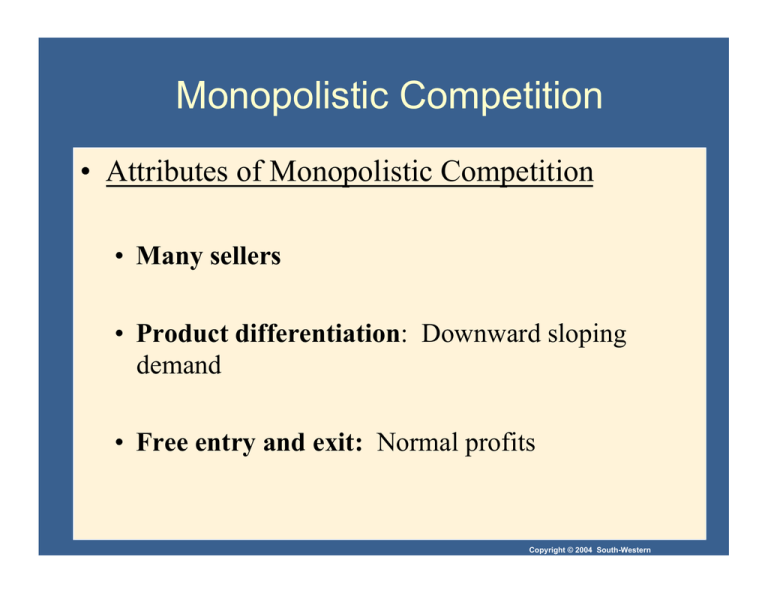
Monopolistic Competition • Attributes of Monopolistic Competition • Many sellers • Product differentiation: Downward sloping demand • Free entry and exit: Normal profits Copyright © 2004 South-Western Monopolistic Competition: Short Run Short-run economic profits encourage new firms to enter the market. This: • Increases the number of products offered. • Reduces demand faced by firms already in the market. • Incumbent firms’ demand curves shift to the left. • Demand for the incumbent firms’ products fall, and their profits decline. Copyright © 2004 South-Western Figure 1 Monopolistic Competition in the Short Run (a) Firm Makes Profit Price MC ATC Price Average total cost Demand Profit MR 0 Profitmaximizing quantity Quantity Copyright©2003 Southwestern/Thomson Learning Monopolistic Competition: Short Run Short-run economic losses encourage firms to exit the market. This: • Decreases the number of products offered. • Increases demand faced by the remaining firms. • Shifts the remaining firms’ demand curves to the right. • Increases the remaining firms’ profits. Copyright © 2004 South-Western Figure 1 Monopolistic Competitors in the Short Run (b) Firm Makes Losses Price MC ATC Losses Average total cost Price MR 0 Lossminimizing quantity Demand Quantity Copyright©2003 Southwestern/Thomson Learning The Long-Run Equilibrium • Firms will enter and exit until the firms are making exactly zero economic profits. Copyright © 2004 South-Western Figure 2 A Monopolistic Competitor in the Long Run Price MC ATC P = ATC MR 0 Profit-maximizing quantity Demand Quantity Copyright©2003 Southwestern/Thomson Learning Long-Run Equilibrium: Two Characteristics • As in a monopoly, P > MC. • Profit maximization requires marginal revenue to equal marginal cost. • The downward-sloping demand curve makes marginal revenue less than price. • As in a perfect comp’n, P = ATC. • Free entry and exit drive economic profit to zero. Copyright © 2004 South-Western Monopolistic versus Perfect Competition • Two differences between monopolistic and perfect competition — excess capacity and markup. Copyright © 2004 South-Western Excess Capacity and Markup (a) Monopolistically Competitive Firm Price (b) Perfectly Competitive Firm Price MC MC ATC ATC Markup P P = MC Marginal cost 0 MR Quantity produced Efficient scale P = MR (demand curve) Demand Quantity 0 Quantity produced = Efficient scale Quantity Excess capacity Copyright©2003 Southwestern/Thomson Learning Monopolistic Competition and the Welfare of Society • There is the normal deadweight loss of monopoly pricing in monopolistic competition caused by the markup of price over marginal cost. • However, the administrative burden of regulating the pricing of all firms that produce differentiated products would be overwhelming. Copyright © 2004 South-Western Monopolistic Comp’n and the Welfare of Society • Another way in which monopolistic competition may be socially inefficient is that the number of firms in the market may not be the “ideal” one. There may be too much or too little entry. • Entry has external costs and benefits. Copyright © 2004 South-Western Product Variety: Positive Externality Because consumers get some consumer surplus from the introduction of a new product, entry of a new firm conveys a positive externality on consumers. Copyright © 2004 South-Western Business Stealing: Negative Externality Because other firms lose customers and profits from the entry of a new competitor, entry of a new firm imposes a negative externality on existing firms. Copyright © 2004 South-Western ADVERTISING • When firms sell differentiated products and charge prices above marginal cost, each firm has an incentive to advertise in order to attract more buyers to its particular product. Copyright © 2004 South-Western Advertising’s Negative Role • Critics of advertising argue that firms advertise in order to manipulate people’s tastes. • They also argue that it impedes competition by implying that products are more different than they truly are. Copyright © 2004 South-Western Advertising’s Positive Role • Defenders argue that advertising provides information to consumers • They also argue that advertising increases competition by offering a greater variety of products and prices. • The willingness of a firm to spend advertising dollars can be a signal to consumers about the quality of the product being offered. Copyright © 2004 South-Western Brand Names Negative Role • Critics argue that brand names cause consumers to perceive differences that do not really exist. Copyright © 2004 South-Western Brand Names Positive Role • Economists have argued that brand names may be a useful way for consumers to ensure that the goods they are buying are of high quality. • providing information about quality. • giving firms incentive to maintain high quality. Copyright © 2004 South-Western
